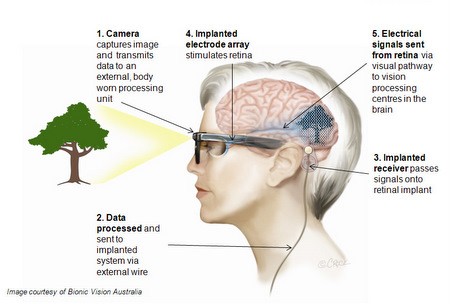
Dianne Ashworth testing her new retinal implant: “All of a sudden I could see a flash of light. It was amazing' (Image: BVA)
Australia has a bit of a history when it comes to pioneering cyborg technology. The country was home to the first functioning bionic ear implant in 1978 and now, in 2012, comes a new version of a bionic eye, with Bionic Vision Australia (BVA) researchers announcing the success of their first retinal implant trial.
Dianne Ashworth, a profoundly blind woman, had the prototype implant switched on last month.
“All of a sudden I could see a flash. It was amazing,” she said.
After years of darkness caused by retinitis pigmentosa, shapes and lights began appearing as electrical impulses from the chip shot along Ms Ashworth's long-disused optic nerves to the vision centers of her brain. What's marvelous is that - unaware of the immense hack taking place - the brain obediently processes the signals, regardless of the fact there's been no sight in the traditional sense. In a world first, surgeons implanted the prototype implant behind Ashworth’s retina, and installed a small wire from her eye to a connector behind her ear.
Researchers can now test the implant with a view to developing a vision processor and external camera.
“These results have fulfilled our best expectations, giving us confidence that with further development we can achieve useful vision," said Professor Emeritus David Penington AC, Chairman of Bionic Vision Australia. "Much still needs to be done in using the current implant to ‘build’ images for Ms Ashworth. The next big step will be when we commence implants of the full devices.”
The BVA eye employs a similar approach to the American developed Argus II, which uses a video camera worn on a headband to provide some vision. The Argus II boasts 60 electrodes while the Australian prototype has 24, but BVA plans to test a vastly improved 1024 electrode implant capable of offering facial recognition and reading large print by 2014.
While the BVA eye is by no means the first - the Argus II is already available in Europe – the Bionic Vision Australia eye is rapidly catching up. And with at least 12 bionic eye projects progressing around the world, the future will certainly be brighter for the profoundly blind. Given that sight accounts for around half of our brain’s sensory input, machine vision will be one hell of a buzz for those who have never been able to see the world.
Source: Bionic Vision Australia
COMMENT:
If this works long term (given the similarity to the cochlear implant it should) it will be a real blessing to many.
PikemanCopyright © gizmag 2003 - 2012 To subscribe or visit go to: http://www.gizmag.com
